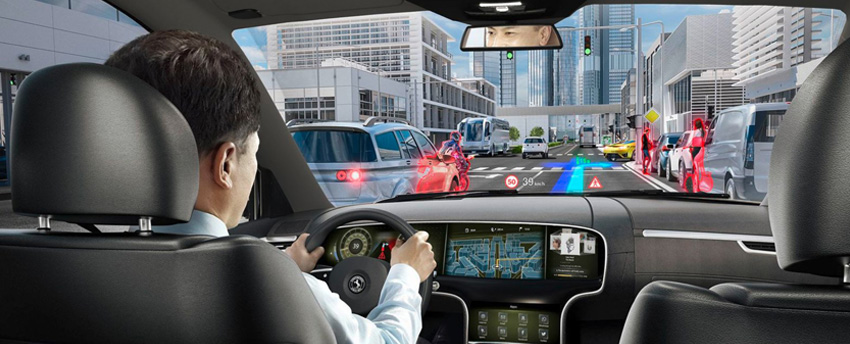Augmented Reality - the most interesting solutions
Augmented Reality - the most interesting solutions
The use of Augmented Reality is becoming more and more widespread in both everyday life and business. What are the most promising solutions of this technology?
In 2018 many new technologies are on the rise. It would be hard to list all of them, but it is for sure that Augmented Reality (or AR) is one of the most exciting ones. It can provide solutions which can change our everyday lives – for example healthcare, transportation, or everyday communication. In today’s article we collected the most interesting solutions that the technology offers.

Augmented Reality – how does it work?
If you have seen Pokémon Go! before, then you are already familiar with the term ‘augmented reality.’ The technology (sometimes also referred to as ‘mixed reality’) adds a computer-generated virtual image to the reality you perceive around you.
AR-based solutions have become more and more sophisticated over the past few years. Think about interior design for example. In a few countries, IKEA has already introduced a programme based on AR technology, which takes into account the features of the clients’ home, so that it can recommend the most appropriate furniture to that particular apartment or house. The customer can see on a monitor or on a smartphone screen what a piece of furniture will look like in their own living room.
In this example (and generally) one of the major challenges is that the image generated by the computer must be completely consistent with reality – like the lighting of the room. The image should also be to scale, and the piece of furniture should not differ from its surroundings on the screen.
In the future, applications based on augmented reality will probably be more interactive and easier to control (either with voice-control, which has already been mentioned in one of our previous articles, or touch). It will also be possible for the virtually displayed image to react to the changes in its surroundings (such as lighting or shadows).
The most interesting solutions
Healthcare
There is no doubt that healthcare is one of the most important areas where augmented reality technology can be used to your benefit. In some cases, an AR-based application may be able to save lives. The special solutions offered by the technology may be used in all stages, such as diagnosis, medication or even surgeries.
- For example, two Canadian university students are working on an AR software which lets you “see” under your skin, so you are able to tell the doctor exactly what hurts and where in your body. The technology was developed with the help of big data: they used X-rays and CT scans in order to create images about the inside of the human body, so that the location of organs may be identified in the case of all individuals. Experts say that the success of the project lays in the fact that it will make laparoscopic surgeries much easier to perform, and it will also play a role in diagnosing illnesses.
- Smart contact lenses are not a new invention – Google has already created such a solution – although their contact lenses can “only” help those who have diabetes. The lenses gather data from tears of the patient in order to identify blood sugar levels, so they can also warn the person if it is too high.
However, a pair of contacts operated by AR can do much more than that. There are experiments with technologies which can actually make the short-sighted see or at least perceive some of their surroundings (since the sense of seeing doesn’t only depend on the eyes, but the brain also has an important role). The point of the technology is the fact that it amplifies the stimuli coming from the outside world in a way that shows a more detailed image to the short-sighted.
Transportation
The next field we think will be changed by AR technology is the automobile industry. The already-tested and the not-introduced-yet functions can affect both the design of cars and the driving experience.
- When you are only at the design stage yet, augmented reality makes it possible to modify the half-finished car in any way. You can test different solutions and appearances. By doing this you can save a lot of time and money, because you don’t need to actually produce the different versions. By using the images created by AR, you can decide which design is the most appealing or the most practical. Visualisations are also easier to make based on a 3D image.
Once the stage of design had ended, the parts still need to be fitted and put together. In this phase, augmented reality can also prove to be useful: you can plan and design the elements with AR technology, and you can virtually put these items together with the ones that had already been manufactured. The workers of the factory can also be provided with training videos, which make work quicker and more effective with the help of 3D images. The German company Volkswagen has been successfully applying this technology when manufacturing their cars.
- Driving itself can also be facilitated by the technology. AR technology may be used in glasses or even in the windshield itself that can function as a screen for the driver – moreover, a Canadian company is experimenting with AR mirrors.
There are a number of solutions in progress right now: one of the two mainstream ideas is that notifications appear on the screen (like email or text alerts). You have to be careful with this version though. It must be ensured that the driver is not distracted by the pop-up notifications. If the technology is ever introduced in every car, there must be strict regulations that come along with them. The aim of the other use of AR technology that can be equally important is helping the driver. The point of this would be displaying objects on the “screen” which amplify visual stimuli from outside or even warning you about the possible dangers on the road.
Communication
If you think about it, non-personal communication – including corporate communication – almost always takes place via just one channel: either in only writing (like emails or text messages) or through voice (like phone calls or even chatbots). With the help of augmented reality, however, this can all change, and all communication acts may include both visual and voice-based stimuli. This can complement the already existing solutions such as video chat and Skype, and it can provide a better experience for the communicating parties.
Augmented reality can also change business communication completely. You can put more creativity into advertising and communicating with your clients. As we have pointed out several times, it is important that you keep up with the changing trends, because the needs of customers are constantly changing, and they need to be stimulated at all times. The more channels you use to call out to your customers, the bigger the chance that they will become faithful clients. We think that the use of augmented reality actually deserves a whole blog post – it is coming in a few weeks, too.
Augmented reality has already changed our lives – just think about the whole Pokémon Go craze that swept through the entire world two years ago. You can be sure that augmented reality is here to stay. It will continue to develop, thus making our lives easier both in everyday situations and in the business sector, too.
Sources: TechRadar, TechCrunch, The Conversation


